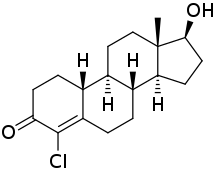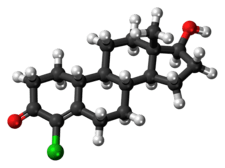Norclostebol
Norclostebol (INN; brand name Lentabol; former developmental code names SKF-6611, CP-73) is a synthetic androgen and anabolic steroid (AAS) that was derived from nandrolone.[1][2][3] It was described in the literature in 1957.[1] Norclostebol is also used as an ester, norclostebol acetate (brand name Anabol 4-19).
 | |
 | |
| Clinical data | |
|---|---|
| Trade names | Lentabol |
| Other names | SKF-6611; CP-73; 4-Chloroestr-4-en-17β-ol-3-one |
| Identifiers | |
| |
| CAS Number | |
| PubChem CID | |
| ChemSpider | |
| UNII | |
| Chemical and physical data | |
| Formula | C18H25ClO2 |
| Molar mass | 308.85 g·mol−1 |
| 3D model (JSmol) | |
| |
| |
| | |
Norclostebol is a 4-chloro derivative of testosterone. It works out to be significantly stronger than pure testosterone. It is approximately 6.6 times as anabolic while only 40% as androgenic. This may not be a particularly fair or valid comparison however. It is more appropriate to compare norclostebol to testosterone propionate due to the use of an ester. In this case they are fairly even in anabolic potency at 112% but only 20–25% as androgenic. In practice this means norclostebol is a potent anabolic compound with minimal tendency towards side effects.
References
- J. Elks (14 November 2014). The Dictionary of Drugs: Chemical Data: Chemical Data, Structures and Bibliographies. Springer. pp. 168–. ISBN 978-1-4757-2085-3.
- Steven B. Karch, MD, FFFLM (9 October 2007). Pathology, Toxicogenetics, and Criminalistics of Drug Abuse. CRC Press. pp. 67–. ISBN 978-1-4200-5456-9.CS1 maint: multiple names: authors list (link)
- James Edward Wright (1982). Anabolic Steroids and Sports: A Comprehensive, Up-to-date Summary and Discussion of the Scientific Findings about the Controversial Drugs Widely Used to Increase Muscle Size and Strength. Sports Science Consultants. ISBN 978-0-9609306-0-9.